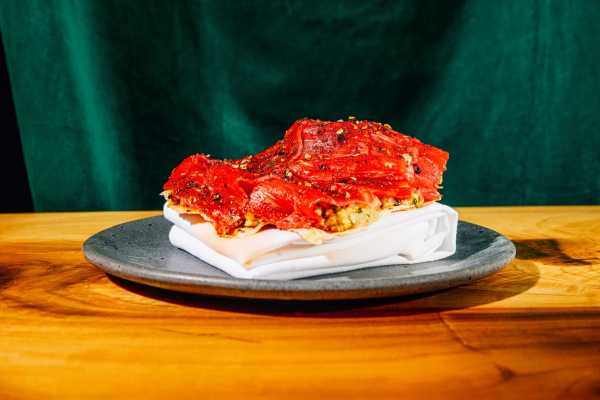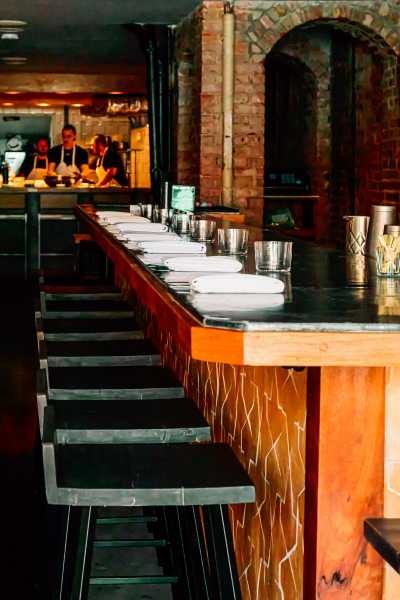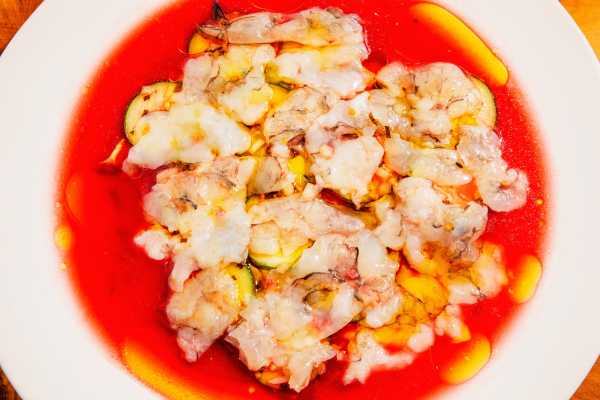
Save this storySave this storySave this storySave this storyYou’re reading the Food Scene newsletter, Helen Rosner’s guide to what, where, and how to eat. Sign up to receive it in your in-box.
Before opening Corima, in a moody, rustic space on the bottom edge of the Lower East Side, the chef Fidel Caballero cooked at some of the city’s most enjoyably weird and cerebral restaurants, including a residency at Rhodora and a tenure at (R.I.P., sigh) Contra, the thimble-size, Michelin-starred downtown tasting-menu restaurant that closed late last year after a decade of service. Caballero, who grew up between El Paso, Texas, and Ciudad Juárez, just over the Mexican border, builds his menu on a foundation of northern Mexican ingredients and techniques—green chilis, flour tortillas, plenty of cheese. Corima is named for korima, a principle of communality central to the way of life of the Tarahumara people, who are indigenous to the Mexican state of Chihuahua. But, as you might expect from Caballero’s C.V., he pulls in elements that take the restaurant well beyond any simplistic category of “Mexican food”: a bit of France, a bit of China, a whole heck of a lot of Japan. Even the tortillas get a cheffy spin. Unconventionally, Caballero makes his with butter, rather than animal fat or oil, and adds a bit of sourdough starter for flavor. The tortillas are cooked one at a time over the back of an inverted wok; a kitchen torch is used to char the exposed face to an ideal level of blistery singe. They run nine dollars apiece (why are other tortillas so inexpensive, anyway?) and are served with a smear of softened, cultured butter, colored umber-orange with recado negro, a Yucatec seasoning blend made from charred chilis and spices.

Shaved raw beef is served over edamame guacamole on a crackery corn tlayuda.
Corima
3 Allen St.
(Dishes $19-$68.)
This attention-grabbing tortilla has already received feature treatment in Eater (“unlike any tortilla in New York”). Grub Street has called it one of the best in the city. Verily, it’s a great tortilla, chewy and dimensional. But it was Caballero’s enormous, jewel-like seasonal sashimi platter that really brought me in the door. It kept turning up in my social-media feeds, a gleaming array of slabs of assorted fish in shades of pink and white. The dish looked like a persuasive distillation of Caballero’s sensibility: a precise, luxurious Japanese framework filled out with Mexican flavors, including a bowl of chiles toreados (blistered over an open flame) and a sunrise-yellow aioli made with charred onions and smoked wheat. During a recent meal at the bar, though, I was confused not to see the platter on the menu; the bartender said that it had just recently been eighty-sixed, and hinted that I wasn’t the first to ask after it. (The dish’s runaway popularity might be why I overheard one customer refer to Corima as a “sushi fusion” restaurant.) The bartender recommended that I instead try the hiramasa crudo: thick, firm-fleshed slices of yellow jack layered with crunchy rectangles of celtuce (a.k.a. stem lettuce), dressed in about a zillion things, including olive oil, soy sauce, a husk-cherry salsa, and a fragrant herb, sesame, and chicharrón dust that was something like a Mexican furikake. Despite the lightness of the raw fish, the flavors were deep and round; if you’re looking for the aesthetic austerity of Caballero’s sashimi platter, you won’t find it here, but the dish is marvellous on its own considerably more maximalist terms.

Corima’s chef, Fidel Caballero, is an alumnus of such cerebral establishments as Contra, the late Michelin-starred tasting-menu restaurant downtown.

The dining room is divided between an à-la-carte menu up front and a tasting menu in the back.
Corima’s kitchen has a special way of coaxing depth out of ingredients. Many of the most successful dishes are slow-cooked, soft-textured. A bowl of ayacote beans, firm-fleshed with satiny insides, comes in a whey-based, chili-spiced broth whose salt and heat are diffused like sunlight on a cloudy day, with a delicate, ragged-edged slice of headcheese (made in-house) floating on top. Duck enmoladas are pure, melting intensity: long-braised dark-meat carnitas in a black-garlic mole, wrapped in a chewy tortilla made from amaranth. It’s blanketed by an opaque white layer of what the menu calls “cotija foam,” which is actually more like an airy sauce mornay, salty and rich. The menu is laced with obscure regional ingredients such as chintixtle, a Oaxacan paste made from dried chilis and dried shrimp, or chicatanas, crisp flying ants that taste like salt and smoke. This makes Caballero’s more obvious moves feel, well, obvious: a blue-corn quesadilla made with asadero cheese somewhat gratuitously pairs huitlacoche—a naturally occurring corn fungus sometimes called “Mexican truffles”—with shaved actual truffle. Cutting through all the big, rich flavors was a zingy dish of shrimp aguachile. The raw crustaceans, smashed flat using a tortilla press, are marinated in a neon-magenta mixture of rhubarb and hibiscus, with sultry, herby notes of shiso and Japanese cherry blossoms. The cocktails, created by Sam Geller, also skew bright and crisp: a Tequila Verde Highball, grass-green with blended cilantro and slightly savory, or the now infamous Uni Gin Sour, the rare stunt cocktail that actually delivers, drawing out salty sea urchin’s latent, lychee-like sweetness.

For a shrimp aguachile, the raw crustaceans are marinated in a neon-magenta mixture of rhubarb and hibiscus.
If you go online to make a reservation at Corima, you’ll notice that you can choose to book an à-la-carte meal or a tasting menu. The latter, served in the back half of the long dining room, is a two-hour undertaking priced at an approachable ninety-eight dollars per person. The tasting menu that I experienced was occasionally brilliant, as with a dish featuring a nixtamalized slab of daikon radish layered with bitter fava stems under a zippy green aguachile foam. But, over all, the menu felt haphazard and disappointing, with too many dull moments and little coherence from dish to dish. There was an earthenware vessel of faux udon (some of the “noodles” are made from potatoes and potato starch, others from chewy strips of cuttlefish) floating in lukewarm corn-husk dashi; a crispy one-bite snack of raw tuna layered with sea lettuce that’s flash-fried, tempura-style, and tastes like salty nothingness; a fairly straightforward slice of dry-aged duck breast presented under shingled slices of persimmon. Each course offered plenty to think about, but the actual eating was sort of a slog.

The Uni Gin Sour, made with sea urchin, is the rare stunt cocktail that actually delivers.
Helen, Help Me!
E-mail your questions about dining, eating, and anything food-related, and Helen may respond in a future newsletter.
Even Cabellero’s miraculous tortillas suffered in the more formal format. Mine arrived alongside a nice little piece of Spanish mackerel doused in sweet, thick amarillito, but the tortilla itself was already cold in the middle and stiffening at the edges—this despite the fact that I was sitting close enough to the kitchen to hear the dough sizzling on the inverted wok. Corima is likely experiencing the growing pains of a young restaurant trying to master two forms of choreography at once. Some of the tasting menu’s best dishes—including a bite-size course of shaved raw beef over edamame guacamole, on a crackery corn tlayuda—were also available on the à-la-carte menu up front. For now, stick to that half of the room. ♦
Sourse: newyorker.com